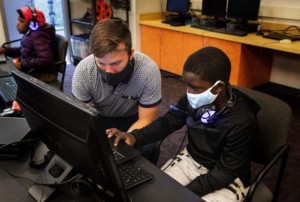How Digital Learning Will Change America
 Most kids use a mobile phone. Most kids spend time online. Most schools prevent both. Our kids are online; it’s time their education was.
Most kids use a mobile phone. Most kids spend time online. Most schools prevent both. Our kids are online; it’s time their education was.
By the end of the decade, most U.S. schools will blend online and onsite learning to customize learning and extend the day and year. Most high school students will do most of their work online. All students (and teachers) will have Internet access devices and broadband. Cloud-based school-as-a-service will provide 24/7 access. The good news is that digital learning won’t cost more and it will boost achievement and graduation rates.
It’s inevitable. We’re a decade behind where we should be in terms of innovation, improvement, and achievement, but the rate of change is increasing. Online learning is growing by more than 30% annually. Like college kids, high school students are blending their own learning where options exist.
And the options are about to get much more interesting. Second generation online learning will be customized to a students level, interests, and motivational profile.
The transition will be uneven depending on state and local leaders. Existing schools ditching textbooks and moving to personal digital learning. New charter schools offer interesting technology blends and themes. Where state funding follows the student to the course level, things will change fast.
This week I’ll be visiting with many of almost 900 charter authorizers. The National Association of Charter School Authorizers is leading the charge for better charter schools. I’ll mention that state policy makers can lead by updating their charter authorizing law (as noted in this blog post on differentiated authorizing strategies) for innovative and online schools.
Qualified applicants with a strong hypothesis should be able to seek conditional approval for innovative school models that incorporate novel assessment systems, performance-based progress, unique staffing and compensation models, distributed learning, blended institutions and/or year-round learning. State commissioners could modify criteria to target specific reforms, populations, or geographies.
Reflecting the Internet’s ability to cross municipal and state borders, virtual and blended school operators should have the ability to enroll students statewide. Only 18 states have authorized statewide virtual charter schools. Lagging states have been protecting districts from competition by denying statewide virtual charters or by providing only a fraction of typical funding with weak rationale.
Susan Patrick from the International Association of K-12 Online Learning and I will encourage authorizers to lead the way in expanding high quality options for students and families.
Now that netbooks and tablets cost less than textbooks, it’s time for schools and districts to embrace digital learning. It’s time for more engagement, more time on task, more productivity. Our kids are online, it’s time their education was.







0 Comments
Leave a Comment
Your email address will not be published. All fields are required.